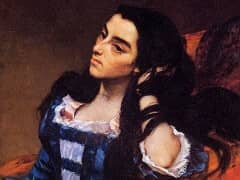Young Woman Arranging Flowers, 1862 by Gustave Courbet

In 1862 Courbet's young friend, the critic Jules Castagnary, introduced the artist to Etienne Baudry, a landowner from Castagnary's native province of the Saintonge in western France. Attracted by Courbet's work, Baudry invited him to come and stay at Rochement, his estate near Saintes. Courbet went to Saintes in May of 1862 and stayed for a year, though not all of the time at Rochemont. He found the place and the people in Baudry's circle agreeable and conducive to work. Baudry was an intellectual, a liberal, and a supporter of the arts who took a great interest in botany and was a serious gardener. The gardens at Rochemont were extensive and equipped with fine greenhouses, and Baudry possessed a large botanical library as well. All of these elements combined to exert a positive influence on the painter. He had painted small flower still lifes as part of a larger composition, as in The Young Ladies on the Banks of the Seine, but here in Saintes for the first time he focused on the painting of flowers for their own sake. In so doing he placed himself in a tradition going back to the trading created by seventeenth-century Dutch painters such as Rembrandt and Vermeer from whom he had long admired and taken as a model in his youth.
The Trellis is the largest and most ambitious of the Saintes flower paintings. Two-thirds of its area is taken up with a cornucopia of richly painted summer flowers, their petals all opened out toward the space of the viewer. Traveling by eye through this mass of finely articulated shape and color is an intensely pleasurable experience. Reversing the usual order that obtains between still life and the human figure, the painting is dominated by the floral profusion, while the young woman is off to one side. Her dark dress with its discreet small floral print pattern is a lightly ironic gloss on the tumbling mass of large living blossoms.
The figure of the young woman herself, her slender youthfulness and good cheer unusual in the artist's repertory of female subjects, is a mark of the lightheartedness that he was permitted to experience in Saintes. The painting was widely admired when it was shown in the exhibition that Courbet and his local friends organized in Saintes in January of 1863.















